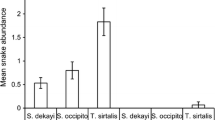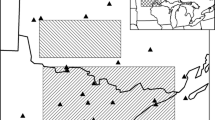Abstract
We investigated the link between thermal quality and the effectiveness of thermoregulation in milk snakes in a thermally challenging environment. We defined thermoregulatory effectiveness as the extent to which an individual maintains its body temperature (T b) closer to the preferred range (T set) than allowed by the thermal quality of its environment. We defined thermal quality as the magnitude of the difference between operative environmental temperatures (T e) and T set. Because ectotherms regulate body temperatures through choice of habitat and behavioural adjustments, we also examined the link between thermoregulation, habitat use and behaviour. During 2003–2004, we located 25 individuals 890 times, and recorded their T b. Thermal quality was lower in the spring and fall than in the summer, and was lower in forests than in open habitats. Milk snakes thermoregulated more effectively in the spring than in the summer and fall, and more effectively in the forest than in open habitats. Milk snakes had a strong preference for open habitats in all seasons, which was likely to facilitate behavioural thermoregulation. The preference for open habitats was equally strong in all seasons and, therefore, the higher effectiveness of thermoregulation was not a result of altered habitat use. Instead, milk snakes modified their behaviour and were seen basking more and moved less in the spring than in the summer.






Similar content being viewed by others
References
Adolph SC (1990) Influence of behavioral thermoregulation on microhabitat use by two Sceloporus lizards. Ecology 71:315–327
Angilletta MJ, Niewiarowski PH, Navas CA (2002) The evolution of thermal physiology in ectotherms. J Therm Biol 27:249–268
Bakken CS (1992) Measurement and application of operative and standard operative temperatures in ecology. Am Zool 32:194–216
Blouin-Demers G, Nadeau P (2005) The cost-benefit model of thermoregulation does not predict lizard thermoregulatory behavior. Ecology 86:560–566
Blouin-Demers G, Weatherhead PJ (2001a) Habitat use by black rat snakes (Elaphe obsoleta obsoleta) in fragmented forests. Ecology 82:2882–2896
Blouin-Demers G, Weatherhead PJ (2001b) Thermal ecology of black rat snakes (Elaphe obsoleta) in a thermally challenging environment. Ecology 82:3025–3043
Blouin-Demers G, Weatherhead PJ (2002) Habitat-specific behavioural thermoregulation by black rat snakes (Elaphe obsoleta obsoleta). Oikos 97:59–68
Blouin-Demers G, Prior KA, Weatherhead PJ (2000a) Patterns of variation in spring emergence by black rat snakes (Elaphe obsoleta obsoleta). Herpetologica 56:175–188
Blouin-Demers G, Weatherhead PJ, Shilton CM, Parent CE, Brown GP (2000b) Use of inhalant anesthetics in three snake species. Contemp Herpetol 2000:4
Blouin-Demers G, Weatherhead PJ, McCracken HA (2003) A test of the thermal coadaptation hypothesis with black rat snakes (Elaphe obsoleta) and northern water snakes (Nerodia sipedon). J Therm Biol 28:331–340
Christian KA, Bedford GS (1995) Seasonal changes in thermoregulation by the frillneck lizard, Chlamydosaurus kingii, in tropical Australia. Ecology 76:124–132
Christian KA, Tracy CR (1981) The effect of the thermal environment on the ability of hatchling Galapagos land iguanas to avoid predation during dispersal. Oecologia 49:218–223
Christian KA, Weavers BW (1996) Thermoregulation of monitor lizards in Australia: an evaluation of methods in thermal biology. Ecol Monogr 66:139–157
Christian KA, Tracy CR, Porter WP (1983) Seasonal shifts in body temperature and use of microhabitats by Galapagos land iguanas (Conolophus Pallidus). Ecology 64:463–468
Cowles RB, Bogert CM (1944) A preliminary study of the thermal requirements of desert reptiles. Bull Am Mus Nat Hist 83:265–296
Dzialowski EM, O’Connor MP (1999) Utility of blood flow to the appendages in physiological control of heat exchange in reptiles. J Therm Biol 24:21–32
ESRI (2000) Arcview 3.2. Environmental Systems Research Institute, Redlands, Calif.
GRASS Development Team (2003) GRASS 5.0.2. General Public License, Trento, Italy
Gregory PT (1982) Reptilian hibernation. In: Gans C, Pough FH (eds) Biology of the reptilia, vol. 13. Academic, London, pp 53–140
Heard GW, Black D, Robertson P (2004) Habitat use by the inland carpet python (Morelia spilota metcalfei: Pythonidae): seasonal relationships with habitat structure and prey distribution in a rural landscape. Aust Ecol 29:446–460
Hertz PE (1992) Temperature regulation in Puerto-Rican Anolis lizards: a field test using null hypotheses. Ecology 73:1405–1417
Hertz PE, Huey RB, Stevenson RD (1993) Evaluating temperature regulation by field-active ectotherms: the fallacy of the inappropriate question. Am Nat 142:796–818
Huey RB (1974) Behavioral thermoregulation in lizards: importance of associated costs. Science 184:1001–1003
Huey RB (1991) Physiological consequences of habitat selection. Am Nat 137:S91–S115
Huey RB, Kingsolver JG (1989) Evolution of thermal sensitivity of ectotherm performance. Trends Ecol Evol 4:131–135
Huey RB, Slatkin M (1976) Cost and benefits of lizard thermoregulation. Q Rev Biol 51:363–384
Huey RB, Peterson CR, Arnold SJ, Porter WP (1989) Hot rocks and not-so-hot rocks: retreat-site selection by garter snakes and its thermal consequences. Ecology 70:931–944
Madsen TRL, Shine R (1996) Seasonal migration of predators and prey: a study of pythons and rats in tropical Australia. Ecology 77:149–156
Matlack GR (1993) Microenvironment variation within and among forest edge sites in the eastern United-States. Biol Conserv 66:185–194
Murcia C (1995) Edge effects in fragmented forests: implications for conservation. Trends Ecol Evol 10:58–62
Peterson CR, Gibson RA, Dorcas ME (1993) Snake thermal ecology: the causes and consequences of body temperature variation. In: Seigel RA, Collins JT (eds) Snakes: ecology and behavior. The Blackburn, Caldwell, pp 241–314
Reinert HK (1984) Habitat variation within sympatric snake populations. Ecology 65:1673–1682
Reinert HK (1993) Habitat selection in snakes. In: Seigel RA, Collins JT (eds) Snakes: ecology and behavior. The Blackburn, Caldwell, pp 201–240
Ruibal R (1961) Thermal relations of five species of tropical lizards. Evolution 15:98–111
SAS Institute (2002) JMP 5.0. Statistical Analysis Systems, Cary, N.C.
Shine R, Lambeck R (1985) A radiotelemetric study of movements, thermoregulation and habitat utilization of arafura filesnakes (Serpentes: Acrochordidae). Herpetologica 41:351–361
Shine R, Lambeck R (1990) Seasonal shifts in the thermoregulatory behavior of Australian blacksnakes, Pseudechis Porphyriacus (Serpentes: Elapidae). J Therm Biol 15:301–305
Taylor EN, DeNardo DF, Malawy MA (2004) A comparison between point and semi-continuous sampling for assessing body temperature in a free-ranging ectotherm. J Therm Biol 29:91–96
Weatherhead PJ, Blouin-Demers G (2004) Long-term effects of radiotelemetry on black ratsnakes. Wildl Soc Bull 32:900–906
Webb JK, Shine R (1998) Using thermal ecology to predict retreat-site selection by an endangered snake species. Biol Conserv 86:233–242
Williams KL (1988) Sytematics and natural history of the American milk snakes, Lampropeltis triangulum. Milwaukee Public Museum, Miwaukee, Wis.
Acknowledgements
We thank G. Bulté and S. Duchesneau for their able help with data collection. We are particularly grateful to H. Duffy for her help, freely given, to many aspects of this study. We also thank staff at the Queen’s University Biological Station for logistical support. As usual, Ray Huey provided a particularly detailed and insightful review for which we are very grateful. Funding for this research was provided by a NSERC discovery grant to G. Blouin-Demers.
Author information
Authors and Affiliations
Corresponding author
Additional information
Communicated by Carlos Martinez del Rio
Rights and permissions
About this article
Cite this article
Row, J.R., Blouin-Demers, G. Thermal quality influences effectiveness of thermoregulation, habitat use, and behaviour in milk snakes. Oecologia 148, 1–11 (2006). https://doi.org/10.1007/s00442-005-0350-7
Received:
Accepted:
Published:
Issue Date:
DOI: https://doi.org/10.1007/s00442-005-0350-7




